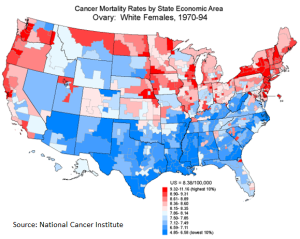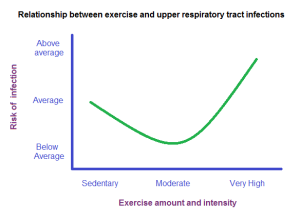FuncMols is a website which pertains to functional molecules, e.g. pharmaceutical and nutraceutical compounds. Among its features, it allows users to compare 3D chemical structures as well as to search for and save commercial sources and scientific literature relating to individual compounds.
Cold Exposure, Brown Fat and Obesity
Published October 11, 2011 Health Leave a CommentTags: adipose, brown fat, cold, obesity, thermogenesis, weight loss
Brown adipose tissue (BAT), primarily found among infants and young children, is linked to protection against obesity and related disorders through its role in energy expenditure and thermogenesis. Compared to white adipose tissue, BAT contains a much higher density of mitochondria. These mitochondria are rich in metabolic enzymes such as iron-containing cytochromes, making the tissue brown. They also contain a unique protein called UCP-1, which dissipates as heat the energy of the electrochemical gradient across the mitochondrial membrane that is usually used to generate ATP, the energy currency of cells.
The varying activity of BAT in people is suggested as a part cause of why some people are susceptible to weight gain with overfeeding, as well as the tendency for weight gain to occur with age since BAT activity seems to reduce with age. The adaptive thermogenesis process, which replaces the shivering response upon repeated cold exposure, is a novel environmental approach to tackling obesity aside from diet and exercise. Clinical trials are currently investigating this may reveal a win-win for both public health and the climate change and fuel challenges of the future.
Antioxidants and Exercise
Published September 20, 2011 Exercise Physiology , Health Leave a CommentTags: aerobic, insulin sensitivity, reactive oxgyen species, supplements, vitamin
Given the complexity of the human body it would be unwise to simply say that reactive oxygen species (ROS) are bad and antioxidants are good. Metabolic by-products of muscle contractions, ROS cause lipid peroxidation and damage the protein machinery of cells, yet they have emerged as also being part of a complex biochemical signaling network in skeletal muscles. Research such as Ristow et al. (2009) suggests that such species are necessary for exercise-induced adaptations since they are prevented by high doses of antioxidants. Muscle function adaptations include contractile protein expression, angiogenesis and mitochondrial biogenesis, as well as increased insulin sensitivity which is one of the most clinically relevant effects of exercise. The biochemical signaling pathways which are activated by exercise have also been shown to up-regulate antioxidant defence enzymes, such as superoxide dismutase, which defend against ROS.
Clinical trials of antioxidant supplements in disease prevention have generally been disappointing. Whilst normal doses of antioxidants from the diet are required to support the defence system, Bouayed and Bohn (2010) suggest that adverse effects may result from the high doses that tend to be used in studies, by interfering with the crucial role that low levels of ROS has in many physiological functions. Also such high doses of single antioxidant compounds may be toxic under certain conditions where other compounds that act in synergy are lacking, such as may be the case with the increased risk of lung cancers among smokers who take beta-carotene supplements. It would interesting to see whether this increased risk is still there if beta-carotene is complemented by a range of other phytonutrients which could act in synergy.
Sun Exposure and Cancer Risk
Published September 12, 2011 Cancer Prevention Leave a CommentTags: melanoma, sunlight, vitamin d
Due to the rapidly increasing malignant melanoma incidence seen across the developed world, sun exposure is generally perceived as having an overall negative effect on health. It is still debated how much of the increased rates has been due to improved surveillance and early diagnosis. Dietary and lifestyle factors may also have contributed. In the opinion of Moan et al. (2008), although a significant proportion of cases are caused by exposure to solar radiation, from vitamin D synthesis there is a net positive health effect of sun exposure, even for total cancer mortality. The increased malignant melanoma rates with decreasing latitude in Europe is thought to be explained by variations in skin pigmentation.
 Variations across North America and Europe showing trends of increased mortality rates for various cancers with increased latitude have supported the hypothesis first made in 1980 by Garland and Garland that vitamin D status accounts for the inverse association between solar UVB radiation exposure and risk of colon cancer. Garland et al. (2009), who mention that there are supportive results for oral intake of vitamin D as well as from sun exposure, provide the following worldwide perspective on vitamin D and cancer prevention.
Variations across North America and Europe showing trends of increased mortality rates for various cancers with increased latitude have supported the hypothesis first made in 1980 by Garland and Garland that vitamin D status accounts for the inverse association between solar UVB radiation exposure and risk of colon cancer. Garland et al. (2009), who mention that there are supportive results for oral intake of vitamin D as well as from sun exposure, provide the following worldwide perspective on vitamin D and cancer prevention.
In regions such as Northern Europe where sunlight during winter is insufficient for vitamin D synthesis, supplementation is necessary to maintain optimal blood concentrations. Supplementation would appear particularly important for dark-skinned people and for African-Americans mortality rates for many of the cancers linked to vitamin D are significantly increased. The small cost of a daily dose of vitamin could be balanced against the burden from cancer attributable to suboptimal vitamin D levels and it must surely be justifiable in many parts of the world.
Exercise, Opioid Peptides and Immune Function
Published September 10, 2011 Exercise Physiology 1 CommentTags: endorphin, immunity, opioid receptors
Exercise, Opioid Peptides and Immune Function
The J-shaped curve illustrates the relationship between the exercise and upper respiratory tract infections:
The graph suggests a protective effect of moderate exercise and that conversely, intense training or a marathon gives a window of opportunity for infection. The varying infection risks appear to be due to changes in immune function, markers of which showing an inverse J-shaped curve.
The boost to natural immune function from moderate exercise lasts up to several hours, with an increased activity of natural killer (NK) cells, which inactivate viruses and reduce the potential of tumour cells to metastasise. This process may help explain the protective effect of exercise against various cancers shown in epidemiological studies.
The activation of opioid pathways in response to physical exercise is well known, as is immunomodulation mediated by opioid peptides. Jonsdottir (2000) describes how evidence has accumulated that the endogenous opioid system is part of the regulatory pathway between the central nervous system and the immune system, as well as giving suggestions for the role of central opioid receptors in mediating the enhanced natural immunity following chronic exercise. These include via both direct nerve fibre connections with cells or organs of the immune system, as well as through neuroendocrine signalling such as via the hypothalamic–pituitary–adrenal axis.
Particulate Air Pollution
Published September 8, 2011 Air Pollution Leave a CommentTags: air pollution, particulate matter
 Over the last decade there has been a clear lack of improvement in air quality and particulate matter concentrations.
Over the last decade there has been a clear lack of improvement in air quality and particulate matter concentrations.
Traffic is the main source of PM in urban areas. Diesel exhausts are rich in ultrafine particles and contain a range of highly toxic substances. Such particles are able to penetrate deep within the lungs into the alveolar region, where oxygen exchange occurs. Over the last 25 years, the health effects have been uncovered by high-powered studies looking at particle concentrations and mortality. It is thought that a 7-8 month loss in life expectancy can be attributed to air pollution, and this has been compared to a 2-3 month loss per person for both second hand smoking and car accidents. The health effects on individuals will vary according to different exposures and susceptibilities.
Indicators of road traffic emissions show a lack of any sustained improvements since 2002 and a recent air quality study ranking European cities according to how well they tackled particulate air pollution between 2005 and 2010 shows that London is not far from the bottom. This appears likely to be due to increasing traffic volumes as well as less than expected emission reductions from the introduction of new vehicle emissions standards, which suggests a discrepancy between test cycles and real world driving conditions. A lack of political will means that significant air quality improvements for UK urban areas are unlikely anytime soon.
Cancer Chemoprevention and Diet
Published September 3, 2011 Cancer Prevention ClosedTags: cancer prevention, chemoprevention, cruciferous vegetables, sulforaphane
Much of the increasing burden from cancer is preventable. Unlike with cardiovascular disease where risk factors such as blood pressure and blood lipid profiles can be monitored and treated, the logical steps to prevent cancer are less clear. Except for the use of drugs such as tamoxifene for treating precancerous cells in those at high risk, no preventative agent with an established risk to benefit profile for the prevention of cancer exists. The carcinogenesis process takes over 20 years and the idea behind a chemotherapeutic agent would be to halt the progression of premalignant cells in order to reduce the risk from cancer. Alas, only healthy diet and lifestyle can be relied upon to do this and which may only have a marginal effect in many cases.
Prostate cancer serves as a good model for studying how dietary and lifestyle factors may influence disease incidence. A strong disparity exists between Eastern and Western cultures and it has been found that migrants from countries with a low incidence acquire an increased incidence within 20 years of moving to the West. The evidence for dietary components which are protective against prostate cancer are neatly summarised in an article by Venkateswaran and Klotz (2010), in Nature Reviews Urology, 2010. Highlighted are the micronutrients EGCG and lycopene from green tea and tomatoes, as well as isothiocyanates from eating cruciferous vegetables which are formed by rearrangement reactions following the hydrolysis of glucosinolates by the action of myrosinase enzymes in the plant tissue or the action of gut microflora. Different isothiocyanates are formed according to the specific glucosinolate precursor, for example sulforaphane is derived from glucoraphanin and allyl isothiocyanate, which gives mustard its pungent taste, is derived from sinigrin.
The different vegetables have various glucosinolate composition, with brussel sprouts being the king of the Cruciferae. Absorption of isothiocyanates is believed to be greater following ingestion of raw brassica with active plant myrosinase than after consumption of the cooked plant with denatured myrosinase. Further information is available here.


